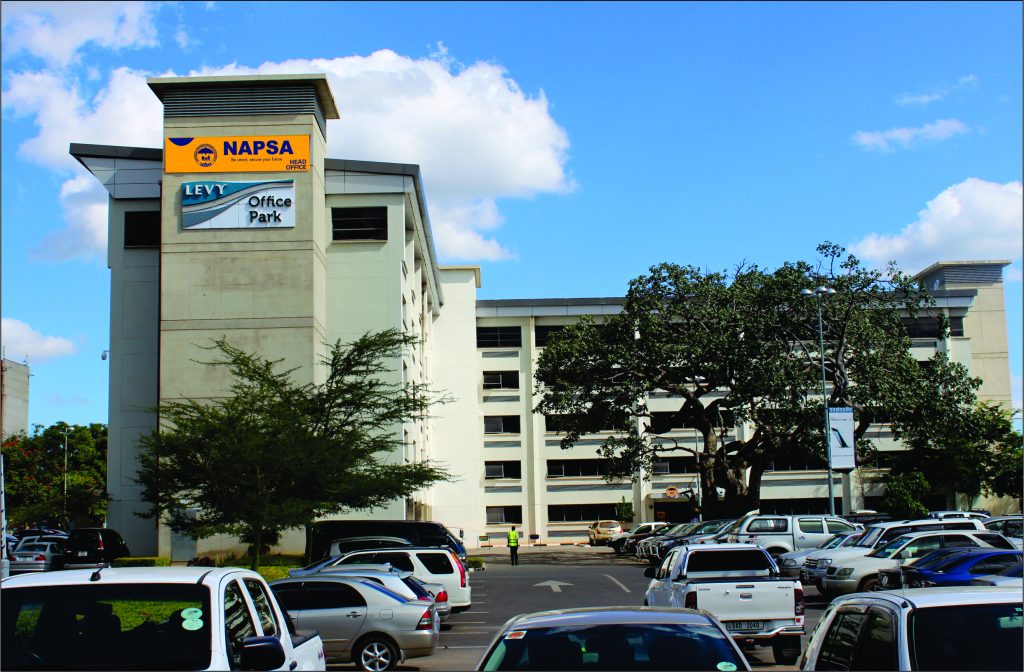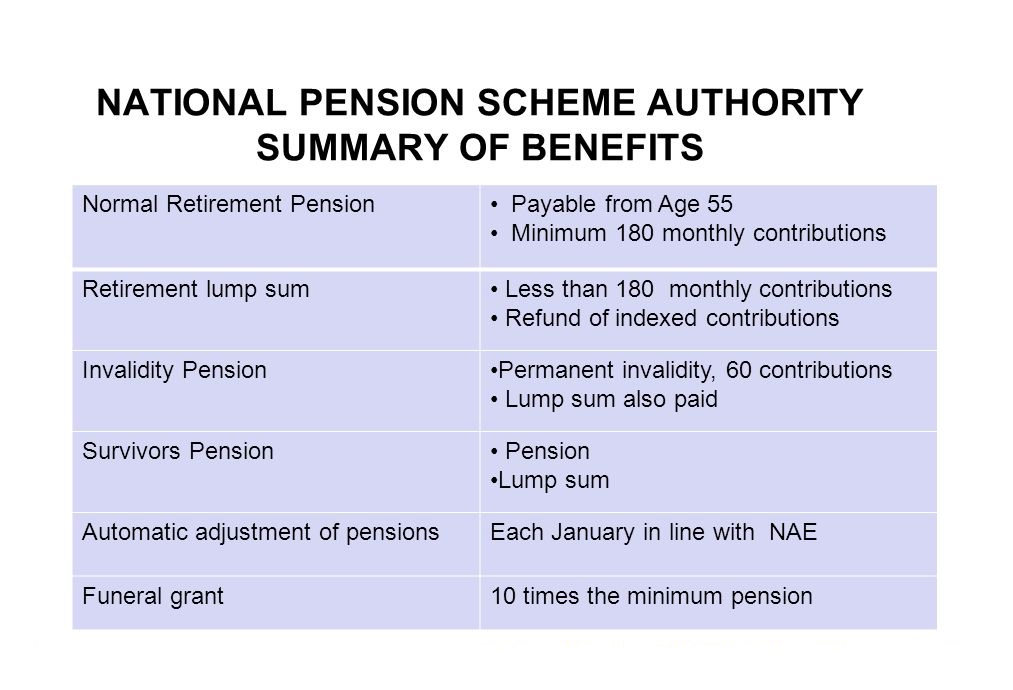What is National Pension Scheme Authority (NAPSA)?
The National Pension Scheme Authority (NAPSA) was established in February 2000 by the National Pension Scheme Act no. 40 of 1996 of the Laws of Zambia.
This followed the closure of the Zambia National Provident Fund (ZNPF) after the responsible Act under which it was formed was repealed. This means that ZNPF stopped receiving contributions on 31stJanuary 2000.
NAPSA was formed to provide income security against the risk arising from retirement (old age), death and invalidity with a focus on adequacy of benefits and monthly receipt of pension in a better way than the repealed ZNPF. This is achieved through the payment of different kinds of benefits to its members.
Who is a member of NAPSA?
A member of NAPSA is one who has duly registered with NAPSA, has been issued with a Social Security number (and card) and contributes to the scheme in accordance with the National Pension Scheme Act. No. 40 of 1996 of the laws of Zambia.
This person is eligible upon retirement or invalidity to receive a benefit payment from NAPSA.
Employees Eligible for NPSA registration
As membership to the National Pension Scheme is compulsory and the following employees among many others are covered:
- Employees engaged on Part time.
- Employees on probation or casual basis.
- Employees engaged on Permanent basis.
- Employees on contract.
- Domestic workers
- Non Zambians engaged by local institutions.
- Public Service workers who joined the civil service after 1st February, 2000
- In all the above types of employees they should be aged between 16 and 55 years of age
Conversely, there are some classes of employees who are exempted from NAPSA membership which include:
- Non Zambians employed by international organizations or those that enjoy diplomatic status.
- All the workers aged 55 years and above are exempted because they are above retirement age according to the prevailing statutory requirement. Similarly, it is not legal in Zambia, to employ workers below the age of 16 as they are minors.
- Workers earning below K15.00 are also exempted from NAPSA. In a bid to try and cover every worker, Pay As You Earn tax exemptions do not affect NAPSA deductions in any way. This therefore implies that wage levels that are exempted from PAYE, are not exempted from NAPSA for as long as they are above K15.00
- Members of the armed forces are equally exempted, but it should be noted that civilians engaged in the Zambia Air Force, Zambia Army, the Police Service and other related wings of Armed Forces; are eligible members of NAPSA.
How should workers Register with NAPSA?
Registration of workers has also been simplified by completing and submitting a prescribed Member Registration/Amendment Form no. NPS 421. This form is obtainable at any NAPSA office, including mobile offices, for those in far and remote areas. It is very important for members to complete this form because
- It enables NAPSA to create a Social Security Number especially for them
- It is also a way that NAPSA can have information about them as members.
- Through the completion of the same form, they also nominate the beneficiaries in the event that a member dies.
The Member Registration/Amendment form plays a cardinal role where a member is concerned. Therefore, a member can complete this form as many times as possible in cases where they have changed employment, gotten married or divorced/separated. They can also fill in when there is a new baby born in the family or when any of their nominated beneficiaries dies.
Registration of NON-ZAMBIANS
It is important for all to note that any non-Zambian employed in Zambia is also expected to submit correct information to the Authority. The following is therefore the position of the Authority regarding their registration:
- All non-Zambians are obliged under the National Registration Act to obtain NRCs within two weeks of entry into the country if their stay exceeds three months.
- Hence, any filled in member registration forms without NRC numbers will be regarded as invalid.
Download Payroll Software for Zambia!
When should employees Register with NAPSA?
Employees should make sure they fill out a new form whenever any of the following happens:
- At employment or change of employer
- Change of marital status
- Birth of a Child

Facts about the Contribution process
While there are many important facts about the process of paying contributions, the following are very key for every employer and employee to know:
- The National Pension Scheme is contributory; meaning that workers covered by the scheme are supposed to make monthly contributions through their employers in order to garner rights that entitle them to benefits provided by the scheme.
- Presently the monthly contribution rate is pegged at 10 percent of a worker’s gross monthly earnings subject to the prevailing contribution ceiling in the calendar year in which the worker earned the income. The contribution ceiling is revised annually and the revision takes effect from January of each year.
- The following constitute gross earnings for NAPSA purposes:
Basic Salary plus:
- Leave pay
- Commuted days
- Overtime
- Bonus
- All Allowances (House, transport, uniform etc.)
- Gratuity
- The employer is however, mandated to deduct only half of the worker’s monthly payable contribution from the employee’s earnings and then add an equal portion.
- Employers are also required to remit workers’ monthly contributions within 10 days of the end of the calendar month to which the earnings relate. i.e. contributions for salaries earned in the month of July should be paid by 10th The due date is the end of each month; the extra 10 days are just a grace period. Any contribution including underpayment that is not paid within 10 days of the end of the calendar month to which it relates attracts a penalty equal to 20 percent cumulative for each month or part thereof the contribution remains unpaid.
- Alongside the payment of contributions, employers are mandated to provide monthly returns that reflect the workers’ full names, social security number, national registration card number, gross earnings and the respective employee and employer contribution.
- A return is deemed to be a good return if it has the following:
- Correct NRC numbers (and correct format)
- Correct Social Security numbers (and correct format)
- Full Names
- Must reflect the gross wage.
- Must use the correct ceiling where applicable
- Failure by an employer to submit monthly returns reflecting the above details result in delays in posting contributions to members’ accounts including possible posting of contributions to incorrect members’ accounts.
- The ideal and acceptable mode of filing your returns is the electronic format. This format has the following benefits:
- Better Record Management – ease filing & retrieval of data
- Error free assessments
- Faster and error free crediting of members’ accounts
- Quicker processing cycle for Benefits
- The ultimate effect of submission of poor monthly returns by employers is that it renders the Authority’s desire to process claims within a reasonable time frame unattainable.
- The Authority has principally two payment channels through which employers can remit contributions to the scheme. The first channel is the Over the Counter (OTC), where employers have to physically visit a NAPSA office to make payment. The second channel is the Electronic payment option. Under this option, employers can either send a hardcopy instruction to their bank or initiate the payment from their Bank internet payment platform.
- The Authority is further in the process of enhancing the electronic payment channel in order to integrate the payment of contributions with monthly returns submission. It is hoped that the new payment channel will address the current challenge of poor information provision by employers through the automation of data validation before the system accepts the payment for contribution.
- In order to improve the quality of contribution data the Authority holds for each contributor, workers are encouraged to regularly check the status of their contributions by visiting a NAPSA office or checking via the NAPSA online platform or using their mobile phone by either downloading the smartphone app or dialing *677#.
- It is further an employee’s obligation to report any errors on the statements in order to ensure that when s/he becomes eligible for a benefit, their claim is not only settled in good time but that the correct amount is paid.
How are benefits calculated?
All lump sum benefits are determined using the following components:
- Total employee contributions
- Total employer contributions
- Index amount (compensation for loss of value)
- Interest amount
Normal retirement and survivor’s pension benefits are determined using the following components:
- Salary – average indexed monthly earnings
- Replacement rate (0.001111XM),
Where M =Months of pensionable employment
Early retirement pension benefits are determined using the following components:
- Salary – average indexed monthly earnings
- Replacement rate (0.001111XM),
Where M =Months of pensionable employment
- Number of months between early retirement and attainment of normal retirement
Invalidity pension benefits are determined using the following components:
- Compensation for lost years
- Salary – average indexed monthly earnings
- Number of years lost from works as a result of invalidity
- Greater of monthly pension and minimum pension

What is the lowest pension NAPSA pays?
NAPSA law provides for a minimum pension. This is the lowest monthly retirement or invalidity pension payable in a given year and is computed as follows:
20% of the National Average Earnings (NAE) applicable in the year of retirement or invalidity, as obtained from the Central Statistical Office.
How long are pensions paid for?
NAPSA monthly pensions are paid to the member for life, and are converted to a survivor’s pension if the member passes away. Invalidity pensions are converted to retirement pensions when the member attains normal retirement age.
Continued payment of the pension is dependent on annual submission of a pension life certificate by all pensioners (retirement, invalidity and survivor’s).


Leave A Comment
You must be logged in to post a comment.